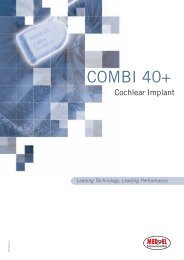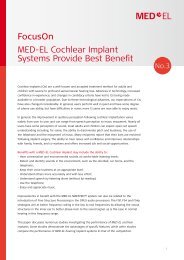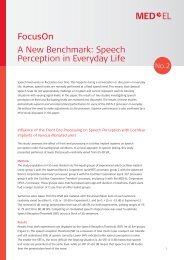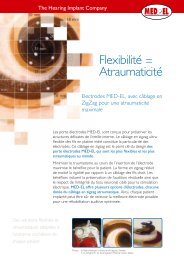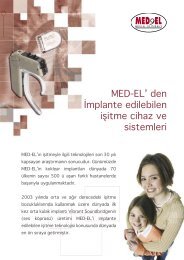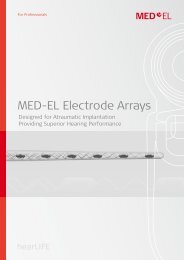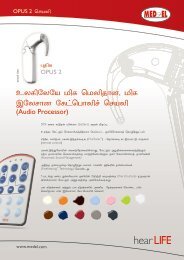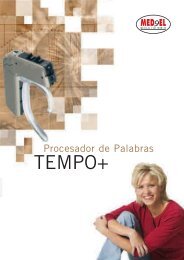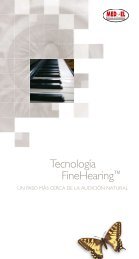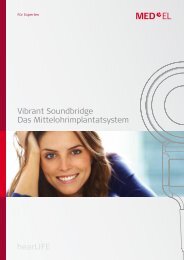My Diary - Med-El
My Diary - Med-El
My Diary - Med-El
You also want an ePaper? Increase the reach of your titles
YUMPU automatically turns print PDFs into web optimized ePapers that Google loves.
<strong>My</strong><br />
<strong>Diary</strong><br />
Veekmans, K., Kühn-Inacker, H., Almadin, S., D`Haese, P.
Child`s<br />
picture<br />
Hello, <strong>My</strong> name is...........................................<br />
<strong>My</strong> birthday is on...............................................<br />
and my hearing aids were first fitted on.........................................<br />
I received my cochlear implant on..............................<br />
in my...............................ear / both ears.<br />
I had my operation in the<br />
clinic of:......................................................................................................................<br />
<strong>My</strong> processor was switched on and programmed<br />
on...................................................in...................................................,<br />
ever since, I can hear!<br />
... and this is a booklet about my first 6 months<br />
of hearing experience.
DATE:<br />
1. What was the most important observation for you this week?<br />
What might you observe at the beginning?<br />
In the first weeks after the switch on of the processor or hearing aids, your child will probably<br />
show a lot of different and new reactions to voices and environmental sounds. Right now, the<br />
device may not be programmed to pick up soft sounds, so don’t be disappointed if s/he fails to<br />
pick them up. Children need to get used to sounds and we don’t want to scare them. Over time,<br />
the program will be changed and then s/he will be able to hear these softer sounds.<br />
What kind of reactions might you observe? Maybe your child…<br />
❏ doesn’t react yet<br />
❏ wakes up<br />
❏ quietens, or becomes attentive, or stops what s/he’s doing<br />
❏ starts to move<br />
❏ starts to suck<br />
❏ blinks<br />
❏ changes facial expression<br />
❏ becomes interested and turns to you<br />
❏ starts to use his/her voice<br />
❏ startles, or shows signs of discomfort<br />
❏ cries, or turns away<br />
It is important for the programming process that you observe which sounds elicit a happy or curious<br />
reaction from your child, and which sounds startle or produce discomfort for your child (and what kind<br />
of sounds and how loud they are).
WEEK 1<br />
A small reminder,<br />
to fill out the list with<br />
your child’s first words.<br />
Thank you !<br />
2. How does your child react when you put on the device (CI or HA)? What about<br />
when you take it off?<br />
3. We want you to list the sounds your child responds to. How loud were they? What<br />
was the reaction to them?<br />
Sounds: Loudness: Reaction:
DATE:<br />
1. What did you notice about your child’s reactions to sounds this week? Please<br />
list some examples.<br />
Make hearing a pleasurable experience<br />
Your child will learn about a whole new range of sounds, voices and noises. This can be very<br />
confusing, and s/he needs to learn to recognize patterns in repeated sounds. Remember, speech<br />
may be just another of these “sound-patterns” right now to your child. Children perform best at<br />
this when there is not too much background noise or an overload of sounds in their everyday<br />
environment. They learn more when they hear a specific sound repeatedly and the activity is<br />
fun, simple and pleasurable. Make sure s/he realizes that YOU make noises too.<br />
Here are a few suggestions to support your child in learning to listen:<br />
❏ If possible, turn off the TV or radio when you are playing listening games with your child<br />
(no background noise).<br />
❏ Repeat sounds a few times. Repetition is important when learning to hear.<br />
❏ Let your child see what or who produces the noise, so your child can link the sound with the<br />
object/person.<br />
❏ Introduce hearing-routines and rituals. A song before bedtime is a wonderful habit to develop.<br />
The most important thing is: hearing should be fun!
2. When do you put your child’s<br />
speech processor/hearing aids on, and<br />
when do you take it/them off? How does<br />
your child react when you do this?<br />
3. Can you describe the hearing environment of your child? In other words, what sorts<br />
of sounds can be heard and learned in your home, such as the coffee machine, the clock,<br />
etc.?<br />
WEEK 2<br />
How does your child react to a<br />
loud, clear sound?<br />
Knock on the table or knock on the door<br />
(behind your child), how does s/he react?<br />
❏ S/he startles<br />
❏ S/he is looking for the noise<br />
❏ S/he doesn’t really react to it.<br />
4. Are there any sounds in your home that might make it difficult for your child to<br />
learn how to listen? If yes, which sounds? Is there street or traffic noise?
DATE:<br />
1. Which of your child’s reactions made an impression on you during the last week?<br />
Did you know?<br />
Speech is a complex and flexible system; we combine<br />
phonemes, the building blocks of speech, into words,<br />
and words into sentences, and sentences into a conversation.<br />
To do this, we need to first hear the speech<br />
around us (speech detection), then we need to learn<br />
to understand it (speech understanding) and finally,<br />
we must learn to produce the first words ourselves<br />
(speech production).<br />
Very quickly children realize that speech isn’t just a<br />
sequence of sounds, but a meaningful tool we use to<br />
socialize and to interact with each other. We speak to<br />
inform others, to get information from others, and to<br />
establish social relationships. Some first signs of<br />
communication are playing with eye contact, mimicking,<br />
and gestures. This interactive play between you<br />
and your child is your first dialogue and the foundation<br />
for speech development. Speech develops naturally<br />
during these every day interactions with your<br />
child! We’ll talk more about communication in the<br />
following week.
WEEK 3<br />
2. How does your child make you<br />
understand what s/he wants? For exam-<br />
ple: when s/he wants to have something,<br />
or when s/he wants to play a particular<br />
game...<br />
How does your child react when<br />
you turn on their device?<br />
Please indicate which answer is<br />
most appropriate.<br />
❏ I don’t see any changes.<br />
❏ S/he immediately starts to use his/her<br />
voice and make sounds.<br />
❏ After approx. half an hour s/he starts to<br />
make more sounds.<br />
❏ It takes a while, but I notice changes as<br />
time goes by.<br />
❏ S/he seems to be more attentive.<br />
3. Does your child make eye contact when you talk to him/her?
DATE:<br />
1. What did your child do this week that made you really happy?<br />
Speech as an instrument for communication and social interaction<br />
Children develop speech during play and everyday activities. Because of this, it is important that<br />
you both engage in the same activity and interact with one another.<br />
The more your child is able to make eye contact with you and the more you respond to your<br />
child’s actions and expressions, the more your child wants to “tell” you, and the more your child<br />
enjoys communication (babble, cry, talk). S/he will realize that s/he can achieve something, for<br />
example: “Mum looks at me, my mum tells me things, or she brings me something”. This will<br />
encourage your child to communicate further, and to take the lead during the activity or play.<br />
How can you give positive responses back to your child? There are many responses that have a<br />
positive effect on your child’s communication and play. For example, you can repeat what your<br />
child said, or just comment on it. You can answer a question, or ask for more information. All of<br />
these reactions can be used, without giving your child the impression s/he wasn’t saying it correctly<br />
in the first place (this would discourage your child from producing sounds).
WEEK 4<br />
2. What sort of games do you play with your child?<br />
3. Is your child in a nursery or daycare? ❏ Yes ❏ No<br />
4. With whom does your child play? Whom does your child spend time with<br />
during the day?
For drawing, painting and photos...
DATE:<br />
1. Please, note some things that happened in your child’s development this week?
WEEK 5<br />
The Itsy, Bitsy Spider<br />
(British English: Incey Wincey Spider) Please visit the BBC website for more games and songs under:<br />
http://www.bbc.co.uk/parenting/play_and_do/toddlers_music.shtml<br />
The itsy, bitsy spider put finger to opposite thumb and pretend to crawl up<br />
Went up the water spout. wiggle fingers from top of “spout” down to lap<br />
Down came the rain move hands/arms across lap, like the motion of “safe” in<br />
And washed the spider out. a baseball game<br />
Out came the sun move hands in large circles to show sun coming out<br />
And dried up all the rain,<br />
And the itsy, bitsy spider show spider going back up again<br />
Went up the spout again.
DATE:<br />
1. What were the most interesting observations this week?<br />
The speech feedback loop<br />
When infants cry, vocalize (use their voice) or babble they can hear themselves. This encourages<br />
them to continue vocalizing and reinforces them to vocalize or babble even more. We call<br />
this the “speech feedback loop,” which is essential for speech development. Very often, after<br />
children have been fitted with a hearing aid or cochlear implant, we can start to hear changes<br />
in their voices and sound patterns. Clearly they can hear themselves and thus change their<br />
speech production. Children who already started vocalizing or using words before they got their<br />
cochlear implant commonly change their voice patterns after a relatively short period of time.<br />
Children who hadn’t used their voices may start to vocalize now, and start babbling: bababab<br />
dadadada bada bada bada. We can observe these changes, given that the hearing aids supply<br />
sufficient amplification.
WEEK 6<br />
How long can your child<br />
attentively listen to you?<br />
When listening to a nursery<br />
rhyme, song or story?<br />
❏ < 1 min<br />
❏ 1 – 3 min<br />
❏ 3 – 5 min<br />
❏ > 5 min:..................min<br />
2. Has your child started to vocalize or babble? If yes, can you please describe which<br />
sounds/words your child makes when s/he wears the processor/hearing aids?
DATE:<br />
1. Please, note down something special that happened this week?<br />
2. Are there sounds your child likes in particular? If yes, can you list them?<br />
What is that sound I hear?<br />
Slowly your child is getting used to hearing. S/he will react more and more to single sounds that<br />
are regularly heard. S/he will learn the context in which they occur and to which objects they<br />
belong. For example, the telephone rings in the hall. You can support your child in this learning<br />
process by drawing attention to the same sounds over and over again. You can show the<br />
object that makes the sound. For example, show the keys that make the noise when you're jingling<br />
them. It is important that your child knows what s/he hears, and is able to connect sounds<br />
and their meaning. Your child will also learn how s/he has to react to certain sounds. “What<br />
should I do when I hear this noise?” For example, show your child that you open the door when<br />
daddy knocks!
WEEK 7<br />
3. Are there sounds your child reacts to<br />
consistently? If yes, can you list them?<br />
Which sounds does your<br />
child best respond to?<br />
❏ voices of familiar people<br />
❏ music<br />
❏ other sounds<br />
How does your child respond to<br />
voices?<br />
❏ I cannot observe a reaction<br />
,<br />
❏ S/he smiles or becomes quiet<br />
❏ S/he makes body movements<br />
(arms – legs)<br />
❏ S/he looks at the talker<br />
❏ S/he starts to vocalize (uses<br />
own voice)<br />
❏ Other reactions: ___________<br />
__________________________<br />
__________________________<br />
4. Are there sounds to which your child doesn’t respond? If yes, can you list them?
DATE:<br />
1. What was the most important change you observed in your child’s reactions<br />
this week?<br />
Why is music important in daily life?<br />
Music is fun! All children love to hear songs, rhymes and stories over and over again. Children<br />
like you to repeat yourself; it is not boring for them. On top of that, it is important in helping<br />
them to learn to hear and listen.<br />
That is why you cannot offer too many “hearing rituals” to your child. You could sing a bedtime<br />
song every evening or you could always say the same nursery rhyme before you eat. But just as<br />
useful are daily routines, where you always repeat the same sentences. “Lets go to bed, put on<br />
your pajamas and brush your teeth!” By having such a ritual, your child will learn through repetition<br />
the words and sentences and their meaning in the specific situation. Songs and music<br />
routines serve many functions, but in the end it is the pleasure that it gives which is of primary<br />
importance!
WEEK 8<br />
Is there music in your<br />
child’s home<br />
environment? Please,<br />
check any that apply.<br />
❏ We are not used to music in our<br />
home<br />
❏ In the background the radio is<br />
turned on softly<br />
❏ We listen together to children’s<br />
songs our child likes<br />
❏ We (sometimes) sing during<br />
daily activities<br />
❏ We play an instrument and<br />
practice in the house<br />
2. What happens if you turn on some music? How does your child react?
For drawing, painting and photos...
DATE:<br />
1. What was the most important change you observed in your child’s reactions<br />
this week?
WEEK 9<br />
Children’s song<br />
(http://www.bbc.co.uk/cbeebies/tweeni<br />
es/songtime/songs/t/tommythumb.sht<br />
ml)<br />
Tommy Thumb, Tommy Thumb<br />
Where are you?<br />
Here I am, here I am<br />
How do you do?<br />
Peter Pointer, Peter Pointer<br />
Where are you?<br />
Here I am, here I am<br />
How do you do?<br />
Toby Tall, Toby Tall<br />
Where are you?<br />
Here I am, here I am<br />
How do you do?<br />
Ruby Ring, Ruby Ring<br />
Where are you?<br />
Here I am, here I am<br />
How do you do?<br />
Baby Small, Baby Small<br />
Where are you?<br />
Here I am, here I am<br />
How do you do?<br />
Fingers all, Fingers all<br />
Where are you?<br />
Here we are, here we are<br />
How do you do?<br />
If you can, visit the BBC website<br />
http://www.bbc.co.uk/parenting/play_a<br />
nd_do/toddlers_music.shtml for more<br />
ideas, or find books of songs and<br />
rhymes in your local library, where the<br />
staff will be pleased to help you.
DATE:<br />
1. What changes have you noticed in your child this week?<br />
Discovering voices and sounds<br />
In the last few weeks your child has heard with<br />
an implant or hearing aids. S/he got used to<br />
hearing voices and sounds, and likely you will<br />
have observed which sounds your child reacts<br />
to very clearly, and which ones s/he doesn’t<br />
respond to at all. As they practice hearing,<br />
children will start to show a more definite<br />
response to sound. At first, they only react to<br />
very loud sounds. After they get used to hearing<br />
these sounds, they will also respond to softer<br />
sounds. Most children react more clearly to<br />
voices than to other sounds in their environment.<br />
Children also tend to respond more to<br />
high-pitched sounds than to low-pitched<br />
sounds. In children with hearing impairment,<br />
this depends on sufficient amplification of the<br />
higher pitches. Gradually, children learn to tell<br />
the difference between sounds in their environment,<br />
first between the clearly distinct<br />
sounds, and later on between similar sounds.<br />
Let’s observe what sounds and voices interest<br />
your child.<br />
If you are not sure about your child’s responses,<br />
or if you notice that your child does not develop<br />
any interest in sounds at all, we recommend<br />
you to speak to a member of your hearing services<br />
or implant team. It may be possible that<br />
they need to check the device function or<br />
programming.
WEEK 10<br />
What does your child do<br />
if you start to talk when<br />
you are standing behind<br />
him/her?<br />
❏ Stops playing and turns his/her<br />
head<br />
❏ Looks around to find you<br />
❏ Nothing (no obvious response)<br />
❏ Reacts, but does not try to<br />
locate you. How does s/he do<br />
this?<br />
___________________________<br />
___________________________<br />
2. Is your child interested in new sounds? Does your child explore the environment for<br />
new sounds? If yes, which sounds?
DATE:<br />
1. What was the most important thing that happened to your child this week?<br />
2. Can you hear different emotions in your child’s vocalizations?<br />
How does voice production change over time?<br />
In the speech development of children with normal hearing, we see that the production of vowellike<br />
(a, e, i, o, u) sounds starts when crying reduces. The auditory skills develop at the same time<br />
as the mouth-motor skills, and the deliberate breathing required for babbling. Around 6 months<br />
of age children also start to produce more and more consonants (m, n, b) to make noises that<br />
sound like real “language,” such as “ma” “da” “pa.”<br />
In children with hearing impairment, the fine mouth-motor skills have already developed further<br />
than auditory skills because they typically have much less auditory experience (if they weren’t<br />
fitted with sufficient amplification before the age of 4 weeks). For this reason, pronunciation of<br />
vowel- and consonant-like sounds is possible with less than 6 months hearing experience. The<br />
ability to hear themselves now (week 6) will give them the opportunity to experiment and play<br />
with their voice. The development of consonants is seen as one of the milestones in speech<br />
development. Maybe you can listen to your child’s speech production and write down the sounds<br />
s/he produces in this diary.
WEEK 11<br />
3. How does your child let you know that s/he is?<br />
a. Happy:<br />
b. Sad:<br />
c. Angry:<br />
d. Uncomfortable:<br />
e. Hungry:<br />
f. Tired:<br />
g. Other:
DATE:<br />
1. What were the things that you noticed this week? What stood out for you this<br />
week?
WEEK 12<br />
Let’s see if your child tries to imitate you when<br />
you make “speech noises”<br />
Try a long aaaaaaah, how does your child react?<br />
❏ S/he is able to imitate correctly<br />
❏ S/he tried to imitate, but it didn’t sound right<br />
❏ S/he made the right lip shape, but without any sound<br />
❏ S/he did not respond<br />
Now try several short versions a-a-a-a, how does s/he react?<br />
❏ S/he is able to imitate correctly<br />
❏ S/he tried to imitate, but it didn’t sound right<br />
❏ S/he made the right lip shape, but without any sound<br />
❏ S/he did not respond<br />
Here is a different sound ooooooh, how does s/he react?<br />
❏ S/he is able to imitate correctly<br />
❏ S/he tried to imitate, but it didn’t sound right<br />
❏ S/he made the right lip shape, but without any sound<br />
❏ S/he did not respond<br />
Now try short ones again: o-o-o-o, how does s/he react?<br />
❏ S/he is able to imitate correctly<br />
❏ S/he tried to imitate, but it didn’t sound right<br />
❏ S/he made the right lip shape, but without any sound<br />
❏ S/he did not respond<br />
When you would like to try more?<br />
Try with eeeee, ma-ma-ma, ga-ga-ga, etc.<br />
This is a fun game to play with your child and it is good speech<br />
practice as well.
For drawing, painting and photos...
DATE:<br />
1. Have you noticed any changes in your child this week? If yes, what were they?<br />
How do parents speak to their children?<br />
When parents, or adults in general, speak to their<br />
babies and young children, they use a very special kind<br />
of speech. This is called “Motherese,” or “child-oriented<br />
speech,” as fathers also speak to their children in<br />
much the same way. This is to help the child learn to<br />
listen and speak, and is mostly adjusted to the child’s<br />
developmental age.<br />
What does it sound like? It has a higher pitch and care<br />
is taken to produce speech sounds very clearly. Speech<br />
sounds, especially the vowels, are stretched longer and<br />
there is a special rhythm in the speech. When we use<br />
this style of speech, we repeat things over and over, use<br />
fairly short segments and we take care to use correct<br />
grammar. We often translate the sounds in our environment<br />
into “words” (“brum-brum” for car). Because this<br />
style of speech is very melodious and expressive, it<br />
directs the child’s attention towards communication.<br />
In the second year of life (generally) we change the way<br />
in which we speak to our children, and we adapt to<br />
their level of development again. We start to use a more<br />
“adult” style in our intonation, and speech ritual games<br />
become more important (see week 8). This type of<br />
speech is called “supportive speech.” The main function<br />
of this type of speech is to teach the child the<br />
meaning of words and to lay the foundations for a broad<br />
vocabulary. The naming-games are typical for this<br />
stage: “What is this?” “Where is your nose?”
WEEK 13<br />
How does your child react<br />
when you repeat the same<br />
sentence a few times?<br />
❏ S/he becomes more attentive<br />
❏ S/he doesn’t listen anymore<br />
❏ S/he seems to understand me better<br />
2. Are there some familiar sounds and/or voices that your child seems to recognize? Does<br />
your child know where these sounds come from? (Mom's/dad's voice, the doorbell, etc.)
DATE:<br />
1. Did you notice anything interesting about your child this week?<br />
The next milestone of speech development: canonical babbling<br />
Auditory development goes hand in hand with speech development. When children use their<br />
voices now, their utterances start to reflect their mother tongue more and more. Children will<br />
start to take on more of the melody and the sounds of their native language. They start with<br />
repeating the same syllable over and over again (babababa); but later they differentiate these<br />
sequences (mabamaba). In the next stage they start to combine different consonants and vowels<br />
to form the syllables of their first words (da-da). This stage of speech development is called<br />
“canonical babbling.” Children with normal hearing are in this phase at 6 to 10 months of age,<br />
before they gradually move on to the phase of their first words (Jargon). To be able to get to the<br />
phase of canonical babbling, children need to hear and take in the sounds of speech (vowels<br />
and consonants). A hearing impairment is often recognized in children when this babbling<br />
phase doesn’t start, or when babbling sounds very unnatural. This is also a sign of insufficient<br />
amplification. When children don’t hear enough to be able to perceive speech, they will not<br />
develop speech and language themselves. When children are fitted with hearing aids or a<br />
cochlear implant that facilitates speech perception, they often also start to babble. However,<br />
the exact time this starts can vary considerably from child to child.
WEEK 14<br />
2. Does your child use specific vocalizations<br />
for specific objects or persons?<br />
❏ I haven’t noticed this yet<br />
❏ Yes, I did observe this:<br />
_________ for _________<br />
_________ for __________<br />
_________ for __________<br />
_________ for __________<br />
_________ for __________<br />
How many different<br />
syllables does your child<br />
produce?<br />
(ga, ba, da, ma = 4 syllables)<br />
• 1 or 2: which ones?<br />
____________________________<br />
• 3 or 4: which ones?<br />
____________________________<br />
• 4 or more: which ones?<br />
___________________________
DATE:<br />
1. Have you noticed any changes in your child’s development this week?<br />
“Teapot”<br />
Children very much enjoy learning language<br />
through songs and games. The<br />
movements are reminders for the words<br />
that go with them, and the rhythmic cues<br />
in the song facilitate the learning<br />
process. Children also look for more eye<br />
contact with the adult during singing,<br />
and are therefore more alert. Often children<br />
try to sing along, and they vocalize<br />
noticeably more than during a normal<br />
dialogue. Because we use similar words<br />
in rhymes, we call their attention to the<br />
minor differences in the words (stout vs.<br />
spout). This is very important for the<br />
development of clear speech perception.
WEEK 15<br />
“Teapot“<br />
(This can be sung or spoken as a rhyme)<br />
I’m a little teapot short and stout. Bend knees<br />
Here is my handle, here is my spout Put hand on hip with elbow out<br />
The other hand should go out to be a spout<br />
When I get all steamed up,<br />
Hear me shout<br />
Tip me over and pour me out. Pretend to tip over
DATE:<br />
1. What was most interesting for you in your child’s hearing development this week?<br />
Not only hearing develops…<br />
When we observe the development of children with hearing loss, we tend to focus on auditory,<br />
speech and language development, and can lose sight of other skills and abilities the child has<br />
to learn. However, in the first 2 years of life, infants change very quickly and as they grow they<br />
learn many new skills. They learn skills such as, crawling, walking, coordinating their hands and<br />
eyes and playing with other people. Every day they learn something new and exciting. The rate<br />
of development varies for different skills and can be very rapid at times. When your child is concentrating<br />
on their listening skills, s/he might not learn much in terms of standing up straight<br />
and walking. When children start to take their first steps, they might not be concentrating on<br />
the new sounds in their environment. This dynamic, shifting developmental process can be<br />
observed in all children. Therefore it is important not only to observe your child’s auditory, speech<br />
and language development, but also to look at other areas that support general development.
WEEK 16<br />
2. What did you observe in your child’s general development (other areas besides<br />
hearing development) this week?
For drawing, painting and photos...
DATE:<br />
1. Did you notice any changes in your child this week?<br />
More about routines...<br />
We already pointed out the importance of routines in your child’s development (week 8). In<br />
everyday life there are many opportunities to introduce routines, and occasions when you can<br />
always say the same sentences to your child. Even when your child doesn’t understand all the<br />
words in the sentence, s/he will recognize the phrases and learn to understand the situation and<br />
later the individual words.<br />
Examples for every day routines:<br />
Morning: “Good morning are we awake now? Did you sleep well? Are you awake? Come on, get<br />
up…”<br />
Breakfast: “Are you finished? Was it nice? Do you want some more…?”<br />
Routines have 3 essential functions:<br />
1. One of the goals of routines in daily life is to establish auditory patterns by repeating the same<br />
short phrases or songs during an activity. Your child will learn to remember these and remember<br />
the routine that goes with them.<br />
2. Routines are also useful in reducing stress by presenting structure in daily activities: your<br />
child starts to anticipate certain routines, knows what is happening and what will come afterwards.<br />
This habitual process makes your child relaxed and more secure.<br />
3. Routines develop attentive listening behavior. Because these rituals (like a song or rhyme)<br />
have a distinct beginning and end point, your child knows how long s/he will have to listen, and<br />
this facilitates concentration. This attentive behavior is important for the overall process of<br />
“learning to listen.”
WEEK 17<br />
How does your child react if you<br />
sing or play a familiar song or<br />
tune? Please check the most<br />
appropriate response.<br />
<strong>My</strong> Child...<br />
❏ listens very closely (attentively)<br />
❏ starts to vocalize, tries to sing along<br />
❏ attempts to move his/her body in time to<br />
the music<br />
❏ anticipates the sounds & movements,<br />
seems to know what is going to happen<br />
next<br />
❏ doesn’t show a clear reaction<br />
2. Are you playing any listening games (routines) with your child? If yes, which<br />
ones?
DATE:<br />
1. List any changes in your child’s speaking and/or listening development that you’ve<br />
noticed in the last week.<br />
How can you encourage your child<br />
to speak?<br />
Look at your child when s/he “speaks!” We<br />
know that infants with normal hearing use their<br />
voices more if they have eye contact with<br />
another person. You can encourage your child<br />
to “speak” more by picking up on vocalizations<br />
and responding to them. This can be done<br />
either by repeating your child’s expressions, or<br />
by rephrasing them, if necessary. While doing<br />
this, you can use “child oriented speech,” as<br />
discussed in week 13. Children like this, and<br />
in this way you challenge them at their own<br />
level. It is also important to put your child’s<br />
emotions and feelings into words. For example,<br />
when your child is laughing, you could say,<br />
“Yes, we’re having fun, aren't we?” Or when<br />
your child is sad, you could say, “You don’t like<br />
it? What is wrong?” This way you show your<br />
child that you understand and you give them<br />
the words to express their feelings.
WEEK 18<br />
Let’s try this:<br />
Stand behind your child and call<br />
his/her name. What happens?<br />
<strong>My</strong> child…<br />
❏ stops whatever s/he is doing<br />
❏ turns around<br />
❏ doesn’t react<br />
Say “no” to your child. What happens?<br />
<strong>My</strong> child…<br />
❏ doesn’t react<br />
❏ stops whatever s/he is doing<br />
2. Is it possible to motivate your child to speak? How do you do this and when?
DATE:<br />
1. What stood out for you this week?<br />
Noisy games?<br />
Your child has about 4 months of hearing experience now; this means their<br />
hearing age is 4 months. However, play behavior may be developed beyond<br />
4 months of age, depending on his/her chronological (actual) age. The same<br />
holds for your child’s other skills, such as picking up toys or crawling/walking.<br />
Children now have to combine listening skills with all other aspects of their<br />
general development. It might be that their play is enriched with sounds and<br />
vocalizations, or that they enjoy playing with toys that make noise now.<br />
These are signs that their hearing development is incorporated into their<br />
overall development.
WEEK 19
DATE:<br />
1. What happened this week that you think should be noted?<br />
From babbling to words…<br />
You might have observed already that your child understands considerably more words than s/he<br />
can express. When your child is babbling, s/he might also use more and more typical sounds<br />
(vowels and consonants) from your native language. While babbling children are training their<br />
lips and tongues to be able to pronounce the words they will learn at a later stage, as correctly<br />
as possible. At this point they will start to use certain expressions for certain objects, which only<br />
a parent understands. For other people these expressions might still be meaningless and not<br />
understandable. This type of speech (expressions) is called “jargon.” Jargon forms when the first<br />
real words of “adult” speech are used. These first words are probably not yet pronounced<br />
correctly, but they are used more often, and strangers seem to catch their meaning now. When<br />
first words emerge they can vary from child to child. Some children with normal hearing start<br />
to produce their first words before the age of one, others only start at the age of two. Certainly<br />
in children who are hearing impaired, we can observe a very big range. So far, there are no studies<br />
on word-development in very young children with a cochlear implant or hearing aids. Therefore<br />
we would be grateful if you could observe your child closely and note their first words!
WEEK 20<br />
2. Does your child understand some words in the following categories: body parts,<br />
animal or food names? (Please list them.)<br />
3. Does your child “name” various body parts, animals, or food? If yes, please describe<br />
what s/he says.
For drawing, painting and photos...
DATE:<br />
1. What special things happened this week?<br />
2. Do you have the impression your child understands your gestures, some words, or<br />
maybe even some short sentences? If yes, please describe which ones and in which kind of<br />
situation.
WEEK 21<br />
What happens when…<br />
You say your child’s name?<br />
❏ S/he reacts immediately<br />
❏ S/he doesn’t give a clear reaction<br />
You ask your child:<br />
“Where is Mummy, where is Daddy?”<br />
❏ S/he looks at the right person<br />
❏ S/he doesn’t give a clear reaction<br />
You ask your child:<br />
“Where is the dog?” (woof-woof)<br />
“Where is the cat?” (miaow)<br />
❏ S/he looks at the correct animal<br />
❏ S/he doesn’t give a clear reaction<br />
Are there other animal sounds your<br />
child understands or imitates? Here<br />
are some examples: “baa,” “moo.” If<br />
so, please list them below:<br />
_________________________________<br />
_________________________________<br />
_________________________________<br />
_________________________________
DATE:<br />
1. Did anything happen this week? Did you notice any important changes?<br />
How language develops…<br />
You are your child’s “speech model.” Children learn<br />
very effectively if you engage in an activity together,<br />
such as observing a thing, person, or event and talking<br />
about it. This is called “joint attention.” Your<br />
child will learn the meaning of your comments and<br />
what you are talking about. You can also help your<br />
child in their process of learning language, by giving<br />
clear responses to their utterances (see also week 4)<br />
like:<br />
• Repeating the sounds/words your child says. This<br />
will encourage your child to express themselves<br />
even more.<br />
• Changing or rephrasing expressions. This way,<br />
your child hears the correct version of words and<br />
learns new ones.<br />
• Answering wishes and questions. When you are in<br />
conversation with another person, you can let your<br />
child know that you heard them. (“I am talking<br />
now, I will answer your question later.”) By giving<br />
children this information, they know that they are<br />
heard.
WEEK 22<br />
2. Can you describe again how your child<br />
expresses emotions now? Some examples are:<br />
being angry, happy, sad, surprised, annoyed.<br />
Does your child...<br />
...seem to be interested in<br />
normal conversations between<br />
adults? Does s/he focus on the<br />
different speakers?<br />
❏ Yes<br />
❏ No<br />
❏ I don’t know<br />
...try to join in the conversation?<br />
❏ Yes, s/he starts to babble and<br />
vocalize<br />
❏ Yes, s/he picks up words and<br />
tries to imitate them<br />
❏ Yes, s/he uses gestures, mime<br />
and/or sign<br />
❏ No, s/he doesn’t try to join in<br />
...call you, or attract your<br />
attention?<br />
❏ S/he comes to me and uses<br />
signs, mime and/or gesture<br />
❏ S/he calls me using her/his<br />
voice (please describe)<br />
___________________________<br />
___________________________<br />
❏ S/he tries to call my name<br />
(“Mummy,” “Daddy,” …)<br />
❏ S/he doesn’t try to call me
DATE:<br />
1. What was outstanding in your child’s development this week?<br />
Listening and being<br />
attentive<br />
You can see that your child is being<br />
attentive to sounds when s/he detects<br />
new or unexpected sounds and tries to<br />
find their source. However, your child<br />
is also being attentive and listening<br />
when s/he is able to concentrate on<br />
individual sounds and is able to listen<br />
to them for a longer time. (Music, a<br />
song, a story, a rhyme, or sounds coming<br />
from a toy.) This can only occur<br />
when your child learns to ignore<br />
background noises, which are not<br />
important for their activity of the<br />
moment. Therefore, it is also interesting<br />
to observe which sounds your<br />
child ignores, or which sounds your<br />
child can filter out, in order to focus<br />
on the sounds that are relevant at the<br />
moment. It is possible that your child<br />
doesn’t respond to a certain sound,<br />
even though s/he has heard it! This<br />
step is important in learning to listen.<br />
“Hearing,” “listening” and “ignoring”<br />
are all part of auditory development.
WEEK 23<br />
2. Are there any environmental sounds to which your child always reacts? If yes,<br />
please describe:<br />
3. Did your child discover any new sounds this week? If so, did s/he ask what they<br />
meant?<br />
4. Are there any sounds to which your child no longer reacts? Maybe s/he got used to<br />
them or is just ignoring them? Please describe:
DATE:<br />
1. Have there been any changes this week?<br />
How can I draw my child’s attention to speech?<br />
Your child will learn language more easily when speech is interesting and you draw attention to<br />
it. How can you do this?<br />
1. Use facial expressions and gestures to support your communication. It is important that your<br />
speech and gestures give the same information, So as not to confuse your child. Facial expression<br />
and gestures clarify the affective meaning of speech.<br />
When you speak about the lion, your face shows fear and when you speak about your child’s<br />
favorite teddy, your face shows affection.<br />
2. Use child-oriented speech with a specific rhythm and intonation (see week 13) when you<br />
express feelings or ask a question. Guide your child’s attention to certain elements in your<br />
speech.<br />
“I am HAPPY today, because we are going out!” You can say this using a high pitched<br />
“happy” voice, and putting some melody in the phrase.<br />
3. Stress words that are important for your child.<br />
When looking at a picture book together, you could always stress the “duck” that is in the<br />
water, the “duck” that comes out of the pond, the “duck” that… if you want him/her to learn<br />
this word.<br />
4. Make breaks in between words.<br />
When looking at a picture book together, make a little pause to create a certain tension. This<br />
draws your child’s attention to the information that follows the pause.<br />
5. Change your speech rhythm.<br />
When telling a story and the dog starts to run, you could speak faster, and when he lies down<br />
to sleep, you could speak slowly.
WEEK 24<br />
2. Do you play any special finger-games (The Itsy, Bitsy Spider , The Teapot, Here is<br />
the Church) or body-games (Can you keep a secret?, Round and round the garden, This<br />
little piggy) with your child? If yes, which ones do you play and how does your child<br />
react?<br />
This Little Piggy<br />
taken from “tools for shaping children’s lives,” Civitas www.civitas.org.<br />
(can be done on fingers or toes)<br />
This little piggy went to market. touch and wiggle thumb<br />
This little piggy stayed home. touch and wiggle index finger<br />
This little piggy had roast beef. touch and wiggle middle finger<br />
This little piggy had none. touch and wiggle ring finger<br />
And this little piggy cried,<br />
“Wee, wee, wee!” touch and wiggle pinky<br />
All the way home. And gently tickle your child They enjoy it!<br />
3. How does your child react when you speak very animatedly to them?
For drawing, painting and photos...
DATE:<br />
1. What was the most important thing you saw this week?<br />
Looking at picture books together<br />
Most children love picture books. They are very<br />
useful when it comes to encouraging children to<br />
speak. You can name the pictures and repeat the<br />
words over and over again, you can point out the<br />
relationship between the pictures, use new<br />
words, name new things on the pictures, etc.<br />
Especially in the beginning, books with little text<br />
but pleasant pictures are useful. A single picture<br />
can hold a whole story. You could encourage your<br />
child to look at the pictures with you. You could<br />
name the things you see on the picture, and talk<br />
about what is happening in the picture. How<br />
does your child react to this activity? Maybe you<br />
can try looking at a new picture book this week.
WEEK 25<br />
2. Does your child like picture books? If yes,<br />
which ones?<br />
Title of the book, Author of the book:<br />
There are many...<br />
...excellent children’s books with<br />
little or no text, for very small<br />
children. If this is a new activity<br />
for you, you could got to your local<br />
bookshop or library and ask for<br />
children’s picture books, suitable<br />
for your child. There are many to<br />
choose from, and you might want<br />
to try a few different ones before<br />
you find one that your child<br />
really likes.
DATE:<br />
1. List some things that happened in your child’s development this week.<br />
Picking up new words…<br />
Speech is a skill that we acquire naturally<br />
and spontaneously. It is not necessary<br />
to teach children with normal<br />
hearing how to speak. Like many<br />
things we do in daily life, speech is<br />
learned unintentionally. We hear how<br />
somebody speaks about his pet, and<br />
we catch the words “dog” and “barking,”<br />
the intonation and the way things<br />
are said. This form of learning is also<br />
called “implicit learning.” Children<br />
with significant hearing loss often miss<br />
part of the speech signals, due to their<br />
limited auditory perception. Their possibilities<br />
to “pick up” speech are substantially<br />
limited, depending on the<br />
severity of their hearing loss. Their<br />
attention has to be drawn explicitly to<br />
speech. Children with a mild to moderate<br />
hearing loss can normally hear<br />
enough through their hearing aids to<br />
be able to pick up speech sounds and<br />
learn implicitly. A cochlear implant<br />
can possibly do the same for children<br />
with severe to profound hearing loss.<br />
It helps them to perceive speech more<br />
easily, which make it possible to learn<br />
unintentionally. “Implicit learning” is<br />
the least tiring form of learning. Your<br />
child only needs a good model to imitate!
WEEK 26<br />
2. Is your child interested in new words? Does s/he ask you the names of new things?<br />
(“this?”, “ta?”)<br />
3. Does your child attempt to imitate any new words s/he hears? Does s/he<br />
seem to “pick up” new words? If yes, which words?
DATE:<br />
1. What was the most striking observation in your child’s development this week?<br />
2. How does your child react to very loud sounds (door, blender)?<br />
Further programming…<br />
Your child has gathered hearing impressions for about 6 months now and has certainly learned<br />
a lot. S/he probably had a few programming sessions in the last few months. To enable the<br />
audiologist to get to a stable and optimal map, s/he needs to get clear responses to different<br />
sound and speech signals from your child. Your child is probably fairly familiar with the programming<br />
sessions, however, s/he might still act very differently in a clinical situation than at<br />
home. Please keep observing your child in the future, as you have been during these recent<br />
months. What kind of changes have you noticed in your child’s listening development? What<br />
kind of changes occurred at home that you can report to your audiologist?<br />
These routine programming sessions are also important in the future. They reassure you that<br />
your child’s device is working, and that the map has the best settings possible to enable good<br />
listening. It is only then that your child can perceive speech with the best clarity.
WEEK 27<br />
3. How does your child react to very soft<br />
sounds (whispering, soft music)?<br />
*Which environmental<br />
sounds does your child<br />
always recognize?<br />
Please check (multiple answers<br />
are possible)<br />
❏ Doorbell, telephone, music,<br />
knock on the door, vacuum<br />
cleaner, washing machine,<br />
mixer, microwave bell<br />
❏ sirens (ambulance, police),<br />
car horn, birds, dogs, footsteps,<br />
father‘s/mother‘s car,<br />
airplane<br />
❏ Talking, sneezing, coughing,<br />
laughing<br />
❏ Other:____________________<br />
* LiP Protocol, Sue Archbold, Nottingham<br />
Paediatric Implant Programme<br />
4. How does your child react to high (birds singing) or low (wood banging) pitched<br />
sounds?
DATE:<br />
1. What stood out for you this week?<br />
Which are the first words children learn?<br />
As you’ve probably observed yourself, this can vary quite a bit. We are sure their first words are<br />
words they pick up in every-day life, things they see, play with, hear. The first words usually<br />
involve very direct or practical matters, like “dada” for Daddy, or “Teddy,” rather than “think” or<br />
“know.” Later they will also learn words with a more abstract meaning. Other words that are easily<br />
picked up in the early stage of language development are social words, such as “bye bye,”<br />
“Hello,” “dada,” and words like “gone” and “more.” Also the word “no” seems to be among the<br />
first words of many children.<br />
Words with one syllable (car, ball) are typically the easiest ones to pronounce, and certain<br />
phonemes can be easier (b,d,m,p) than others (r,s, t,) to pronounce. Therefore their first words<br />
probably won’t contain these difficult phonemes. Sometimes children have a preference for certain<br />
phonemes, and use them all the time. Children generally learn nouns (name words), then<br />
verbs (action words). Later on social words and adjectives (descriptive words) are added to their<br />
expressions.
WEEK 28<br />
Could we please remind<br />
you to fill out the list<br />
with your child’s first<br />
words again, including<br />
any words spoken up to,<br />
and including, this<br />
week? Thank you in<br />
advance!
For drawing, painting and photos...<br />
Hello, this is me again, I have been hearing for<br />
six months now!<br />
This is how I look now:<br />
Child`s<br />
picture<br />
These first 6 months were very exciting,<br />
I am already looking forward to the next 6 months!
...for notes
22703 1.0<br />
MED-EL <strong>El</strong>ektromedizinische Geräte GmbH<br />
Worldwide Headquarters<br />
Fürstenweg 77a<br />
A-6020 Innsbruck, Austria<br />
Tel: +43-512-28 88 89<br />
Fax: +43-512-29 33 81<br />
office@medel.com<br />
MED-EL GmbH Niederlassung Wien<br />
office@at.medel.com<br />
MED-EL Deutschland GmbH<br />
office@medel.de<br />
MED-EL Deutschland GmbH Büro Berlin<br />
office-berlin@medel.de<br />
MED-EL Unità Locale Italiana<br />
ufficio.italia@medel.com<br />
VIBRANT MED-EL<br />
office@fr.medel.com<br />
MED-EL GmbH Sucursal España<br />
office@es.medel.com<br />
MED-EL GmbH Sucursal em Portugal<br />
office@pt.medel.com<br />
MED-EL UK Ltd<br />
office@medel.co.uk<br />
MED-EL Deutschland GmbH Office Helsinki<br />
office@fi.medel.com<br />
MED-EL Corporation USA<br />
implants@medelus.com<br />
MED-EL Latino America S.R.L.<br />
medel@ar.medel.com<br />
MED-EL Middle East FZE<br />
office@ae.medel.com<br />
MED-EL India Private Ltd<br />
implants@medel.in<br />
MED-EL Hong Kong<br />
Asia Pacific Headquarters<br />
office@hk.medel.com<br />
MED-EL Philippines HQ<br />
office@ph.medel.com<br />
MED-EL China Office<br />
office@medel.net.cn<br />
MED-EL Thailand<br />
office@th.medel.com<br />
MED-EL Malaysia<br />
office@my.medel.com<br />
MED-EL Singapore<br />
office@sg.medel.com<br />
MED-EL Indonesia<br />
office@ind.medel.com<br />
MED-EL Korea<br />
office@kr.medel.com<br />
MED-EL Vietnam<br />
office@vn.medel.com<br />
MED-EL Japan Co., Ltd<br />
info@medel.co.jp<br />
MED-EL Liaison Office Australasia<br />
office@au.medel.com<br />
MED-EL Be<br />
office@be.medel.com



